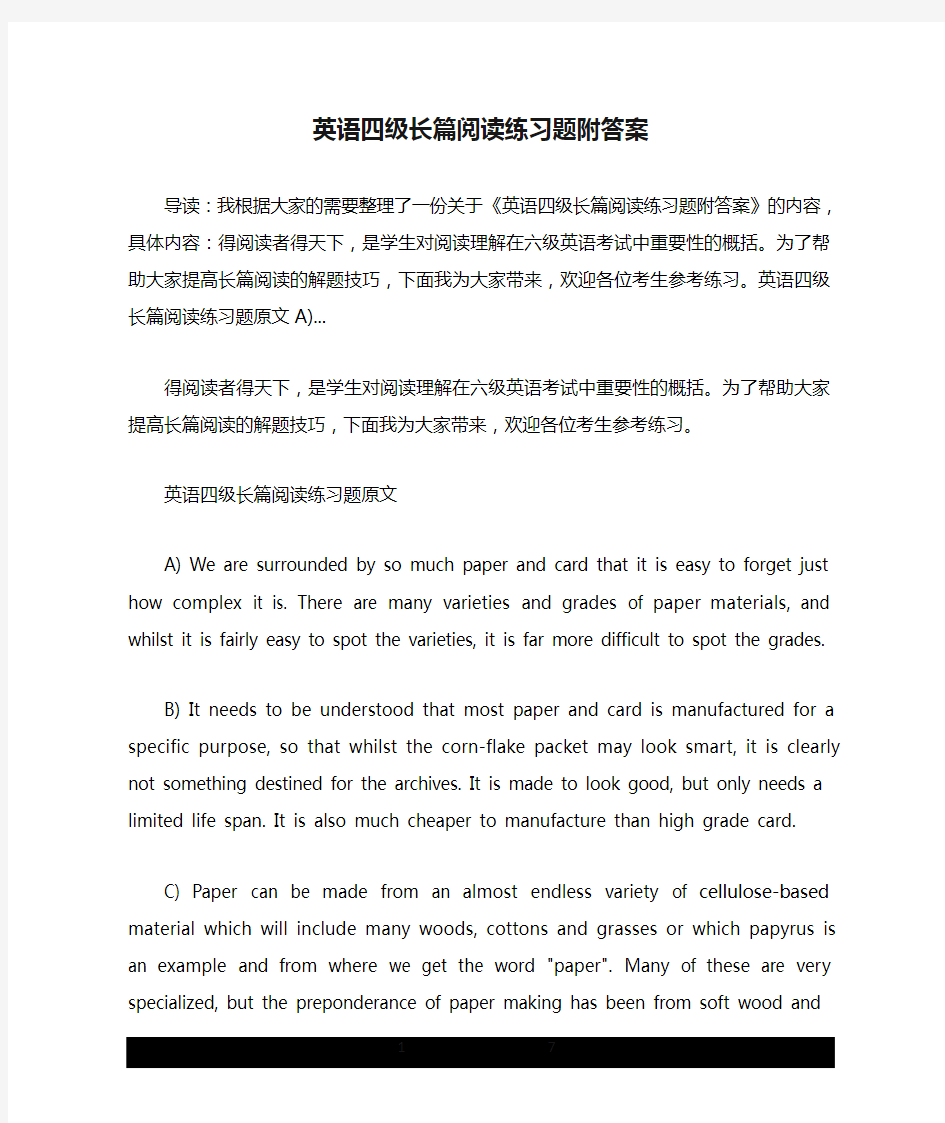英语四级长篇阅读练习题附答案

- 1、下载文档前请自行甄别文档内容的完整性,平台不提供额外的编辑、内容补充、找答案等附加服务。
- 2、"仅部分预览"的文档,不可在线预览部分如存在完整性等问题,可反馈申请退款(可完整预览的文档不适用该条件!)。
- 3、如文档侵犯您的权益,请联系客服反馈,我们会尽快为您处理(人工客服工作时间:9:00-18:30)。
英语四级长篇阅读练习题附答案
导读:我根据大家的需要整理了一份关于《英语四级长篇阅读练习题附答案》的内容,具体内容:得阅读者得天下,是学生对阅读理解在六级英语考试中重要性的概括。为了帮助大家提高长篇阅读的解题技巧,下面我为大家带来,欢迎各位考生参考练习。英语四级长篇阅读练习题原文A)...得阅读者得天下,是学生对阅读理解在六级英语考试中重要性的概括。为了帮助大家提高长篇阅读的解题技巧,下面我为大家带来,欢迎各位考生参考练习。
英语四级长篇阅读练习题原文
A) We are surrounded by so much paper and card that it is easy to forget just how complex it is. There are many varieties and grades of paper materials, and whilst it is fairly easy to spot the varieties, it is far more difficult to spot the grades.
B) It needs to be understood that most paper and card is manufactured for a specific purpose, so that whilst the corn-flake packet may look smart, it is clearly not something destined for the archives. It is made to look good, but only needs a limited life span. It is also much cheaper to manufacture than high grade card.
C) Paper can be made from an almost endless variety of cellulose-based material which will include many woods, cottons and grasses or which papyrus is an example and from where we get the
word "paper". Many of these are very specialized, but the preponderance of paper making has been from soft wood and cotton or rags, with the bulk being wood-based.
Paper from Wood
D) In order to make wood into paper it needs to be broken down into fine strands. Firstly by powerful machinery and then boiled with strong alkalies such as caustic soda, until a fine pulp of cellulose fibers is produced. It is from this pulp that the final product is made, relying on the bonding together of the cellulose into layers. That, in a very small nutshell, is the essence of paper making from wood. However, the reality is rather more complicated. In order to give us our white paper and card, the makers will add bleach and other materials such as china clay and additional chemicals.
E) A further problem with wood is that it contains a material that is not cellulose. Something called lignin. This is essential for the tree since it holds the cellulose fibres together, but if it is incorporated into the manufactured paper it presents archivists with a problem. Lignin eventually breaks down and releases acid products into the paper. This will weaken the bond between the cellulose fibers and the paper will become brittle and look rather brown and careworn. We have all seen this in old newspapers and cheap
paperback books. It has been estimated that most paper back books will have a life of not greater than fifty years. Not what we need for our archives.
F) Since the lignin can be removed from the paper pulp during manufacture, the obvious question is "why is it left in the paper?" The answer lies in the fact that lignin makes up a considerable part of the tree. By leaving the lignin in the pulp a papermaker can increase his paper yield from a tree to some 95%. Removing it means a yield of only 35%. It is clearly uneconomic to remove the lignin for many paper and card applications.
G) It also means, of course, that lignin-free paper is going to be more expensive, but that is nevertheless what the archivist must look for in his supplies. There is no point whatsoever in carefully placing our valuable artifacts in paper or card that is going to hasten their demise. Acid is particularly harmful to photographic materials, causing them to fade and is some cases simply vanish!
H) So, how do we tell a piece of suitable paper or card from one that is unsuitable? You cannot do it by simply looking, and rather disappointingly, you cannot always rely on the label. "Acid-free" might be true inasmuch as a test on the paper may indicate that it is a neutral material at this time. But lignin can take years before it starts the inevitable process of breaking down, and in the right
